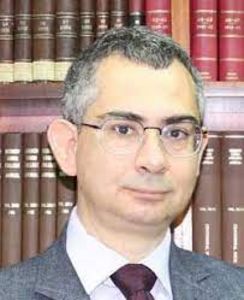- Αρχική
- THE PROGRAM
- ENTRY TO THE PROGRAM: REQUIREMENTS AND PROCEDURES
- FOR THE PSP STUDENTS
- SEMINAR COURSES AND SEMESTER TIMETABLE
-
ACADEMIC STAFF
- SOPHIA ANEZIRI
- VYRON ANTONIADIS
- NIKOS GIANNAKOPOULOS
- NIKOLAS DIMAKIS
- GEORGIOS FERENTINOS
- CHRYSANTHOS KANELLOPOULOS
- LILIAN KARALI-GIANNAKOPOULOU
- STYLIANOS KATAKIS
- EURYDICE KEFALIDOU
- KONSTANTINOS KOPANIAS
- YIANNIS PAPADATOS
- MARIA-GABRIELLA PARISSAKI
- VASSILIS PETRAKIS
- DIMITRIS PLANTZOS
- LEFTERIS PLATON
- SELINI PSOMA
- GIORGOS VAVOURANAKIS
- SOPHIA ZOUMBAKI
- NEWS AND EVENTS
- CONTACT INFORMATION
GIORGOS VAVOURANAKIS

Giorgos Vavouranakis
Professor of Prehistoric Aegean
Giorgos Vavouranakis studied archaeology and art history at the Department of History and Archaeology of the NKUA (1993) and prehistoric archaeology (ΜΑ 1998, PhD 2002) at the University of Sheffield. He was post-doctoral researcher at NKUA (2003-2006), adjunct faculty at the Universities of Crete (2004-2005) and the Peloponnese (2006-2009) and at the Hellenic Open University (2007-2023), and contract archaeologist for the Ministry of Culture and Sports (2003-2004, 2007-2008, 2011). Since 2012 he teaches at the Department of History and Archaeology of the NKUA the subject of “Prehistoric Aegean: Theoretical Archaeology”. He is also Director of the Laboratory of Archaeology and History of Art (2018-2024).
He has participated in the excavation of the Neolithic settlement at Kantou Kouphovounos and has co-directed the rescue excavation of the Early Cypriot tombs at Audemou Kamares, Cyprus. He also participated in the study project of the minoan villas in East Crete. He co-publishes the finds from the excavations of the minoan villa at Makrygialos, the Minoan farmhouse at Azokeramos, the Minoan tholos tomb B at Apesokari and the minoan built tomb at Linares, Siteia. He is second director of the university excavation at the site of Plasi, Marathon. He has published three monographs and over 50 papers in journals (e.g. AJA, JEMAHS, OpAth, ΜΑΑ, RDAC), and international collective volumes (e.g. Hesperia Supplements, Aegaeum, Aegis, AURA), while he has co-edited six collective volumes.
Main research interests
- Aegean prehistory (focus on Crete and the Aegean islands)
- Cypriot prehistory
- Archaeological theory
- Funerary customs
- Bottom-up approaches to the emergence of social complexity and phenomena of authority
- Landscape archaeology
- History of Archaeology
Select publications (since 2016)
- “A post-humanist approach to funerary ritual and its socio-historical significance: The Early and Middle Bronze Age tholos tombs at Apesokari, Crete” in A. Dakouri-Hild και M. Boyd (eds.), Staging Death: Funerary Performance, Architecture and Landscape in the Aegean, Berlin: Walter de Gruyter, 2016, 253-273.
- “The mechanics of cultural hybridization in the Southern Aegean during the third millennium BC, Journal of Eastern Mediterranean Archaeology and Heritage Studies 8.3-4 2020, 299-313 (DOI: 10.5325/jeasmedarcherstu.8.3-4.0299).
- Damilati, K. και Vavouranakis, G. “What future for archaeology’s past?” In M. J. Boyd & R. C. P. Doonan (eds.), Far from Equilibrium: An Archaeology of Energy, Life and Humanity. A Response to the Archaeology of John C. Barrett, Oxford: Oxbow, 2021,115-129.
- Vavouranakis, G. and Catapoti, D. ““Le dur ne dure pas, seul dure le doux”. Rethinking dominant perceptions of the “maritime” in Early Bronze Age Aegean archaeology”, Cahiers «Mondes anciens» [Online], 14 2021(open-access DOI: 10.4000/mondesanciens.3264).
- Mantzourani, E. and Vavouranakis, G. “The anthropomorphic figurines of Cyprus in the Bronze Age. Style, local traditions and foreign associations”, στο G. Bourogiannis (eds.), Beyond Cyprus: Investigating Cypriot Connectivity in the Mediterranean from the Late Bronze Age to the end of the Classical Period, AURA Supplement 9, Athens: AURA and Kardamitsa, 2022. 35-44.
- Image and Archaeology: The Example of Prehistoric Architecture. Athens: Kardamitsa 2021 (in Greek).
- Vavouranakis G. and I. Voskos (eds.), Metioessa, Studies in Honor of Eleni Mantzourani, AURA Supplement 10. Atnes: AURA and Kardamitsa 2022, 193-206 (open-access).
Most of his publications may be found on academia.edu:https://uoa.academia.edu/GiorgosVavouranakis